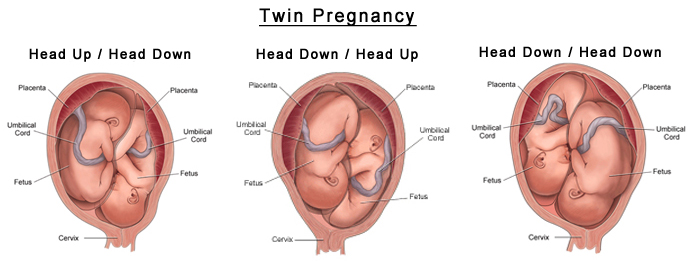
A multiple birth is a pregnancy with two or more fetuses. Names for these include the following:
- twins – two fetuses
- triplets – three fetuses
- quadruplets – four fetuses
- quintuplets – five fetuses
- sextuplets – six fetuses
- septuplets – seven fetuses
While multiples account for only a small percentage of all births (about 3 percent), the multiple birth rate is rising. According to the National Center for Health Statistics, the twin birth rate has risen 70 percent since 1980 and is currently 3.2 per 1,000 live births. The birth rate for triplets and other higher-order multiples has also risen dramatically, but has slowed since 1998.
Women expecting a multiple birth will need to see their health care provider more frequently than if they were having a single pregnancy. Typically, you'll see your provider every two to three weeks during the first trimester of a multiple pregnancy, the American Pregnancy Association says. That's because you are at greater risk for complications, and more frequent visits allow your provider to monitor you more closely.
What Causes Multiple Birth?
There are many factors related to having a multiple pregnancy. Naturally occurring factors include the following:
- Heredity – A family history of multiple pregnancy increases the chances of having twins.
- Older age– Women over 30 have a greater chance of multiple conception. Many women today are delaying childbearing until later in life, and may have twins as a result.
- High parity – Having one or more previous pregnancies, especially a multiple pregnancy, increases the chances of having multiples.
- Race – African-American women are more likely to have twins than any other race. Asian and Native Americans have the lowest twinning rates. Caucasian women, especially those over age 35, have the highest rate of higher-order multiple births (triplets or more).
Other factors that have greatly increased the multiple birth rate in recent years include reproductive technologies, including the following:
- Ovulation-stimulating medications – clomiphene citrate and follicle stimulating hormone (FSH) help produce many eggs, which, if fertilized, can result in multiple babies.
- Assisted reproductive technologies – in vitro fertilization (IVF) and other techniques may help couples conceive. These technologies often use ovulation-stimulating medications to produce multiple eggs, which are then fertilized in the laboratory and returned to the uterus to develop.
How does Multiple Pregnancy Occur?
Multiple birth usually occurs when more than one egg is fertilized and implants in the uterus. This is called fraternal twinning and can produce boys, girls or a combination of both. Fraternal multiples are simply siblings conceived at the same time. However, just as siblings often look alike, fraternal multiples may look very similar. Fraternal multiples each have a separate placenta and amniotic sac.
Sometimes, one egg is fertilized and then divides into two or more embryos. This is called identical twinning and produces all boys, or all girls. Identical multiples are genetically identical, and they usually look so much alike that even parents have a hard time telling them apart. However, these children have different personalities and are distinct individuals. Identical multiples may have individual placentas and amniotic sacs, but most share a placenta with separate sacs. There can be additional complications with identical twins. Rarely, identical twins share one placenta and a single amniotic sac.
Managing Multiple Births
Specific management for multiple births will be determined by your doctor or midwife based on:
- your pregnancy, overall health, and medical history
- the number of fetuses
- your tolerance for specific medications, procedures, or therapies
- expectations for the course of the pregnancy
- your opinion or preference
Management of multiple births may include the following:
- Increased nutrition – Mothers carrying two or more fetuses need more calories, protein and other nutrients, including iron. Higher weight gain is also recommended for multiple pregnancy. The Institute of Medicine recommends that women carrying twins who have a normal body mass index should gain between 37 and 54 pounds. Those who are overweight should gain 31 to 50 pounds; and obese women should gain 25 to 42 pounds.
- More frequent prenatal visits – Multiple pregnancy increases the risk for complications. More frequent visits may help detect complications early enough for effective treatment or management. The mother's nutritional status and weight should also be monitored more closely.
- Referrals – Referral to a maternal-fetal medicine specialist, called a perinatologist, for special testing or ultrasound evaluations, or to coordinate care of complications, may be necessary.
- Increased rest – Some women may also need bedrest – either at home or in the hospital depending on pregnancy complications or the number of fetuses. Higher-order multiple pregnancies often require bedrest starting in the middle of the second trimester. Preventive bed rest has not been shown to prevent preterm birth in multiple pregnancy.
- Maternal and fetal testing – Testing may be needed to monitor the health of the fetuses, especially if there are pregnancy complications.
- Tocolytic medications – Tocolytic medications may be given, if preterm labor occurs, to help slow or stop contractions of the uterus. These may be given orally, in an injection, or intravenously. One of the tocolytic medications often used is magnesium sulfate.
- Corticosteroid medications – Corticosteroid medications may be given to decrease breathing complications and other problems related to premature in babies. Lung immaturity is a major problem of premature babies.
- Cervical cerclage – Cerclage (a procedure used to suture shut the cervical opening) is used for women with cervical insufficiency. This is a condition in which the cervix is physically weak and unable to stay closed during pregnancy. How are Multiple Births Delivered?
Delivery of multiples depends on many factors including the fetal positions, gestational age, and health of mother and fetuses.
Generally, in twins, if both fetuses are in the vertex (head-down) position and there are no other complications, a vaginal delivery is possible. If the first fetus is vertex, but the second is not, the first fetus may be delivered vaginally, then the second is either turned to the vertex position or delivered breech (buttocks are presented first). Occasionally, complications occur during delivery such as prolapsed cord (when the cord slips down through the cervical opening). Emergency cesarean birth of the second fetus may be needed. Usually, if the first fetus is not vertex, both babies are delivered by cesarean. Most triplets and other higher-order multiples are born by cesarean.
Vaginal delivery generally takes place in an operating room because of the greater risks for complications during birth and the potential need for cesarean delivery. Cesarean delivery is usually needed for fetuses that are in abnormal positions, when the mother has certain medical conditions, or when there is fetal distress.

Thank you to Bella Baby Photography for capturing and sharing these Beaumont baby photos. All photographs are supervised and may not be considered safe sleep environments.